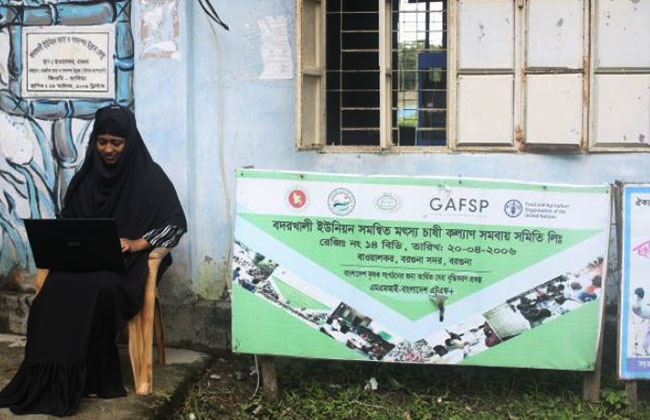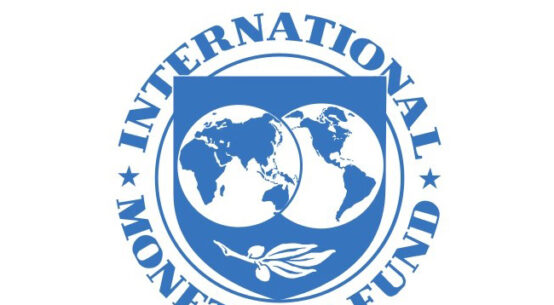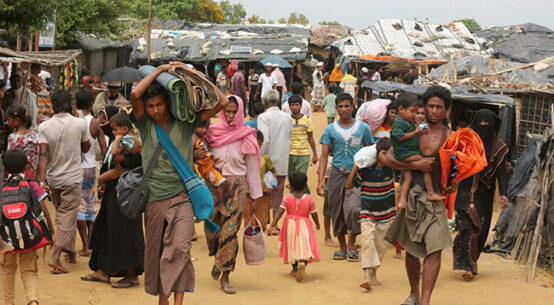
A barefoot young man in rolled-up jeans clutches a laptop as he slogs through a narrow muddy aisle between rice fields on a drizzling late September afternoon. He’s rushing to help a farm couple who are facing trouble with their ducks in a coastal village in southern Bangladesh.
The middle-aged couple, Rafiq Mridha and Nupur Akhter, run a small farm of 0.5 hectares in a district adjoining the Bay of Bengal. In the past year they made a hefty profit and overcame the losses of recent years caused by natural calamities, including the mighty cyclone Sidr, which ripped through the country devastating many districts 15 years ago.
Like Mridha and Akhter, hundreds of villagers in Badarkhali, an area comprising three villages that is extremely exposed to climate change, were made paupers overnight by Sidr but are living an astonishing turnaround thanks to the arrival of digital technology.
In the face of any unsolvable problem, the villagers can now call a local digital service centre, which responds with useful information on a vast range of topics, from farming and selling their crops to getting the local weather forecast.
“For any problem, first we try to find a solution using our smartphones hooked to the internet, and in case of failure, we call people at the digital centre,” Akhter told IPS, adding that the centre taught them how to use technology to get support via mobile phone apps. “The digital centre has eased our life and made our business profitable,” she added.
Akhter said she called the digital centre about her ducks when she couldn’t discover a reason for a decrease in eggs production among some of the fowl. The young man crossing the rice field with his laptop, HM Ranju, was dispatched from the digital centre. He searched online to discover common causes for a decrease in laying eggs and advised the farmer to observe if the ducks were eating properly and to change their feed if they were otherwise healthy.
The problem was potentially serious – every morning year-round the couple earns 700-800 taka (US$7-8) selling duck eggs. “We’re trying to expand the farm regularly,” said Mridha. “We already have over 100 ducks and we’ve ordered more ducklings to be raised for eggs,” adding they had earned $14,800 from the farm last year.
The couple also rears fish and cows on the farm along with growing a variety of vegetables. “As business is going well, we are planning to construct a brick house for ourselves next year,” noted Mridha.
At a call centre run by the digital service centre, worker Laboni Akhter said that most inquiries concern animal feeds and fertilizers or how to control pests and diseases. “We use different types of apps to provide solutions to people’s queries,” she added.
When a village woman arrives at the centre with a photo of a mottled spinach leaf infected with fungal disease, Laboni consults some apps and identifies it as a type of blight. She tells the woman to use fungicides to control it. “If the case is serious, we refer people to the district agriculture or veterinary officers,” Laboni said.
In recent years, most of Badarkhali’s villagers, who earlier made their living by fishing in the Bay of Bengal or nearby rivers, found it difficult and risky to continue the ancestral profession because of changing climate patterns. They opted to start farming fish in ponds in their villages.
Bent on growing the fish farming business together, the fishermen initiated a co-operative in 2005 with the help of a Danish government project. The arrival of digital information technology with the support of the Food and Agriculture Organization of the United Nations (FAO) boosted business further.
The locals have expanded their livelihoods and now almost every household also grows crops and raises animals while Badarkhali is now known as a digital village.
“We’ve developed our digital service centres… we’re connected among ourselves and also with the farmers in other districts across the country,” said co-operative chairman Mohammad Gafur Mia, also a public representative of Badarkhali. “We share information to grow our businesses and maximize profits.”
The co-operative runs two digital service centres, one in a village and another in the market where people can pay to learn to operate computers and common digital technologies. The centres are equipped with three desktop computers, one laptop, three tablet computers, one printer and one scanner.
The FAO introduced the global 1,000 Digital Villages Initiative in Bangladesh to promote digital technology to support inclusive, gender-sensitive rural development and sustainable agri-food transformation to meet Agenda 2030 goals.
A global initiative inspired by FAO’s Director-General, QU Dongyu, the DVI is being piloted in the Asia-Pacific region. Badarkhali is one of nearly 60 villages in Bangladesh being showcased and sharing its advancements with other villages and areas in Asia and the Pacific as well as other regions of the world.
The UN organization works closely with the government and Sara Bangla Krishak Society, a farmers’ network across the country. “FAO is providing the villagers with technological support,” said FAO’s coordinator Mohammad Abu Hanif.
Recalling the horror of Sidr in 2007, Badarkhali villagers said all of their farms were utterly destroyed as tidal waves washed everything away. “Most of the people in the area even couldn’t save a pot for cooking food,” said Mohammad Ali Hossain. In the following years, the village faced more cyclones albeit not as severe as Sidr.
“Now we use our digital devices to follow the weather forecast and know what to do to survive against all odds,” said Ali Hossain.
Many villagers told IPS that there had been a sea change in the area after the arrival of digital technologies, and that they looked forward to other positive changes, such as improved rural governance and improved services. They also believed the FAO initiative would narrow the digital divide among people in the rural and urban areas.
Mosammat Mahmuda said she had recently replaced her shabby thatched house with a brick one thanks to the profits from her work raising fish and poultry. The co-operative provided her with a loan to start the business. “The chances of loss are very slim as the digital service centre provides support to keep fishes and poultry safe from diseases and also to find a market where we can sell the products at a competitive price,” she said.
Once, noticing her fish were not growing at the usual speed, she sought advice from the centre. It told her she was raising too many fish in a small area, so she quickly shifted some to other nearby ponds. Problem solved.
The digital service centre was crucial during the height of the COVID-19 pandemic as the entire country was under lockdown, said another villager, Mohammad Shah Alam. “Our traditional market was closed and we were unfamiliar with virtual marketing, but our digital service centre arranged buyers for our products,” he said.
Many of the villagers felt that they would have faced huge losses without the arrangement.
Osim Roy, general secretary of the co-operative, said only members were allowed to get loans from the organization but any villager could access all the other services from the digital centres by paying a small charge. “Apart from farm-related advice, people at the digital centre can also pay electricity and other bills and fill in any government online forms, mainly for birth or death registration or for a job,” he said.
Before the centre opened, people had to travel four kilometres to go to a market to get these services. “Sometimes, we even go to the people’s houses to deliver the service,” Roy said. (IPS Article)


